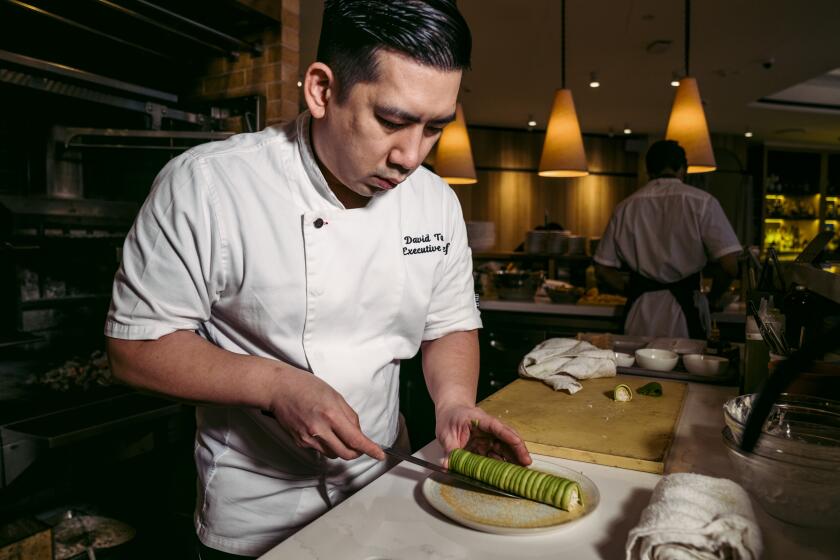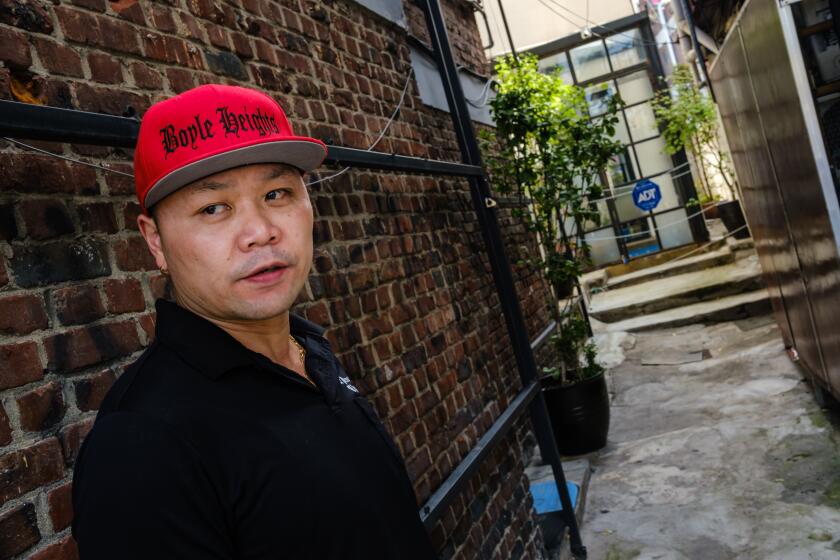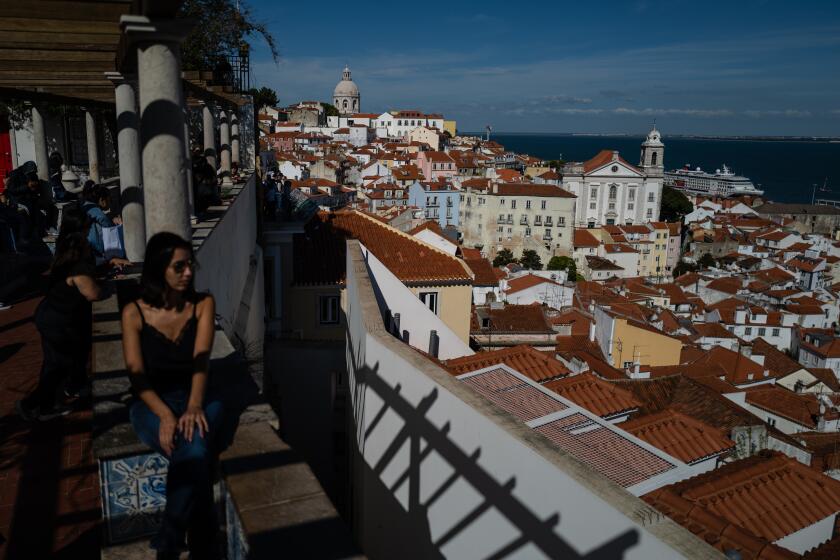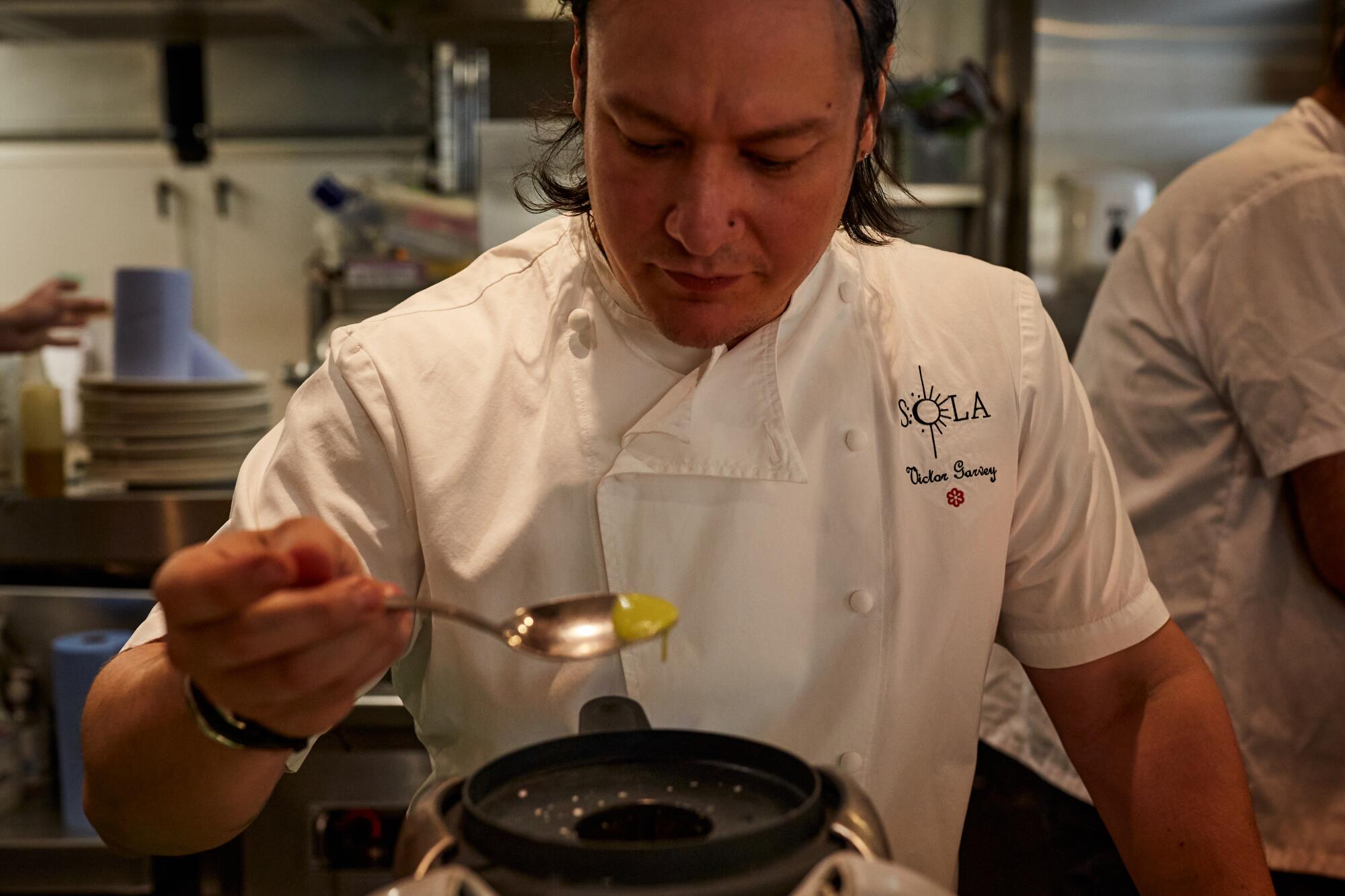
- Share via
LONDON — Perched for display near the front door, the three-grape red blend from Sonoma County is labeled “Geyserville,” giving diners at SOLA Soho a hint of what’s to come.
An American-accented chef with Los Angeles roots roams the tables visiting guests, whose multi-course tasting meal starts with seaweed and sake-cured hamachi served with a vinaigrette made from burnt baby leek, kinako (toasted soybeans) and olive oil from Solano County. Later, dessert kicks off with ice cream flavored by pistachios from the San Joaquin Valley alongside calamansi crema and charentais cantaloupe.
Succulent air plants hang in glass tubes above, as if transplanted from a Joshua Tree sojourn.
It may appear as a gimmick or pretense to create Golden State allure in a nation of dark booths and gloomy weather. But SOLA is Michelin-starred fine-dining, a top-rated destination in London’s bustling Soho district that’s made its name since pandemic-era restaurant rules eased last year and Britons returned to eating out in one of Europe’s biggest and most ethnically diverse cities.
“Californian food is an ethos,” says Victor Garvey, head chef and owner of SOLA, a portmanteau of Soho and Los Angeles in a metropolis better known for its meaty roasts alongside starchy sides and pints of beer or its haute French cuisine and plentiful South Asian, Caribbean and Middle Eastern cookeries.
“A brightness, lightness and freshness,” Garvey says, describing his homage to the West Coast. “We want to bring that to Europe.”
California is having a moment across the Atlantic, where every month brings a new restaurant, chef or menu imported from Los Angeles or San Francisco.

In the last year, L.A. cooks Nancy Silverton of Mozza and Kris Yenbamroong of Night + Market have opened locations in London. Eggslut, the brioche egg sandwich chain that began as an L.A. food truck, now has three cafes in this city. Toca Madera, the club-like West 3rd Street spot where vegan enchiladas are paired with $16 margaritas, opened a rooftop outpost in Marylebone. A restaurant in a hotel in the financial district lures in patrons with two words — Malibu Kitchen — before offering “superfood salads, cured fish and meat, and plant-based dishes.”
Even in Paris, a city skilled at contempt for things American, a chic hotel north of the Seine recently opened Santa Barbara-inspired Montecito. And a chef who once worked the kitchens at Venice’s Gjusta and Gjelina is cooking up California-meets-Nashville cuisine in the 10th arrondissement and will soon launch a spot in the 11th.
Chefs reflect on what it means to bring California into restaurants across the Atlantic.
In Munich and Milan, bright, yellow-accented cafes advertising sunny dishes and avocado toast have popped up with cursive neon signs and wall murals that could pass for a West Hollywood scene made for Instagram. In Ljubljana, a violet-hued cafe is introducing Slovenians to poke bowls inspired by Los Angeles and Honolulu.
“In food, ‘California’ has become a trendy word,” says Mailea Weger, the former chef of Echo, a “deli Californien” that in recent years popularized breakfast chorizo tacos, huevos rancheros and crispy rice bowls for Parisians. “I don’t mean that in a negative way. People recognize California as at the forefront of cuisine. Europeans visit Los Angeles or San Francisco and seem to decide they want a bit of them back home.”
The tiny island nation of Singapore imports more than 90% of its food, but that hasn’t stopped a band of ex-Wolfgang Puck and Mozza workers from opening restaurants celebrating the Golden State and its farm-to-table ethos.
“But no, avocado toast is not the new croissant,” says Weger, who grew up in San Diego and spent 14 years in Venice and Hollywood kitchens, including Gjusta, Gjelina and Tender Greens, while living in Frogtown.
“Perhaps the most significant flaring of organized rebellion” in modern food “took place in California,” a food critic in the Financial Times wrote recently of West Coast cuisine taking root in Britain. “All nations are here, and all leave their culinary footprint. Add in a pot-luck dinner’s worth of climates, plus an open-minded, anything-goes culinary consciousness and you end up with a fine place to be hungry,” said the Mail on Sunday, describing the California experience.
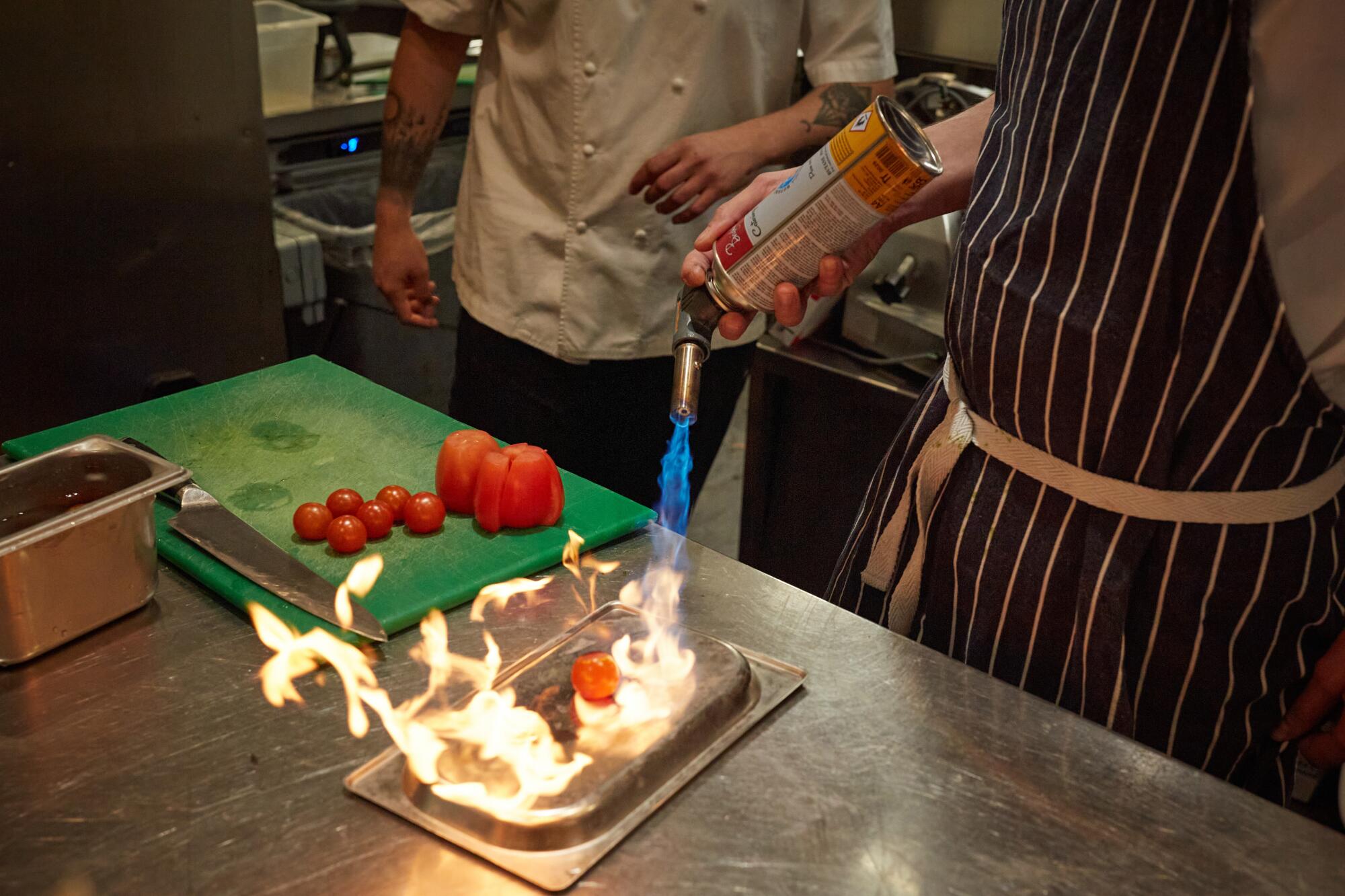
At SOLA, where an 11-course meal costs more than $170 — before nearly $140 in wine pairings — the menu pays homage to California in its own way. Ingredients are mostly seasonal and local, largely purchased from British farmers, with a new dish switched out every few weeks.
With space for about 20 diners at a time during lunch and dinner, Garvey, 36, and his staff have crafted a meeting of Californian, Japanese and, on occasion, French flavors (they show up most in the desserts, where chocolate creme with passion fruit caramel and peanut praline is served). It’s high on citrus, salt, acid and seafood — like Scottish langoustine flambeed table-side over a piping hot lava rock. It’s low on butter, though foie gras dipped in cherry jelly makes its appearances for the taste buds that gravitate toward the creamy, savory and decadent.
It all suggests that cultures can — even amid wars and disturbing nationalism — remain distinct yet mingle to create something shared and new.
Previously, there’s been Colorado lamb and, at another point, artichoke thistles on the menu — flown in from Santa Barbara and baked in gratin and white truffle.
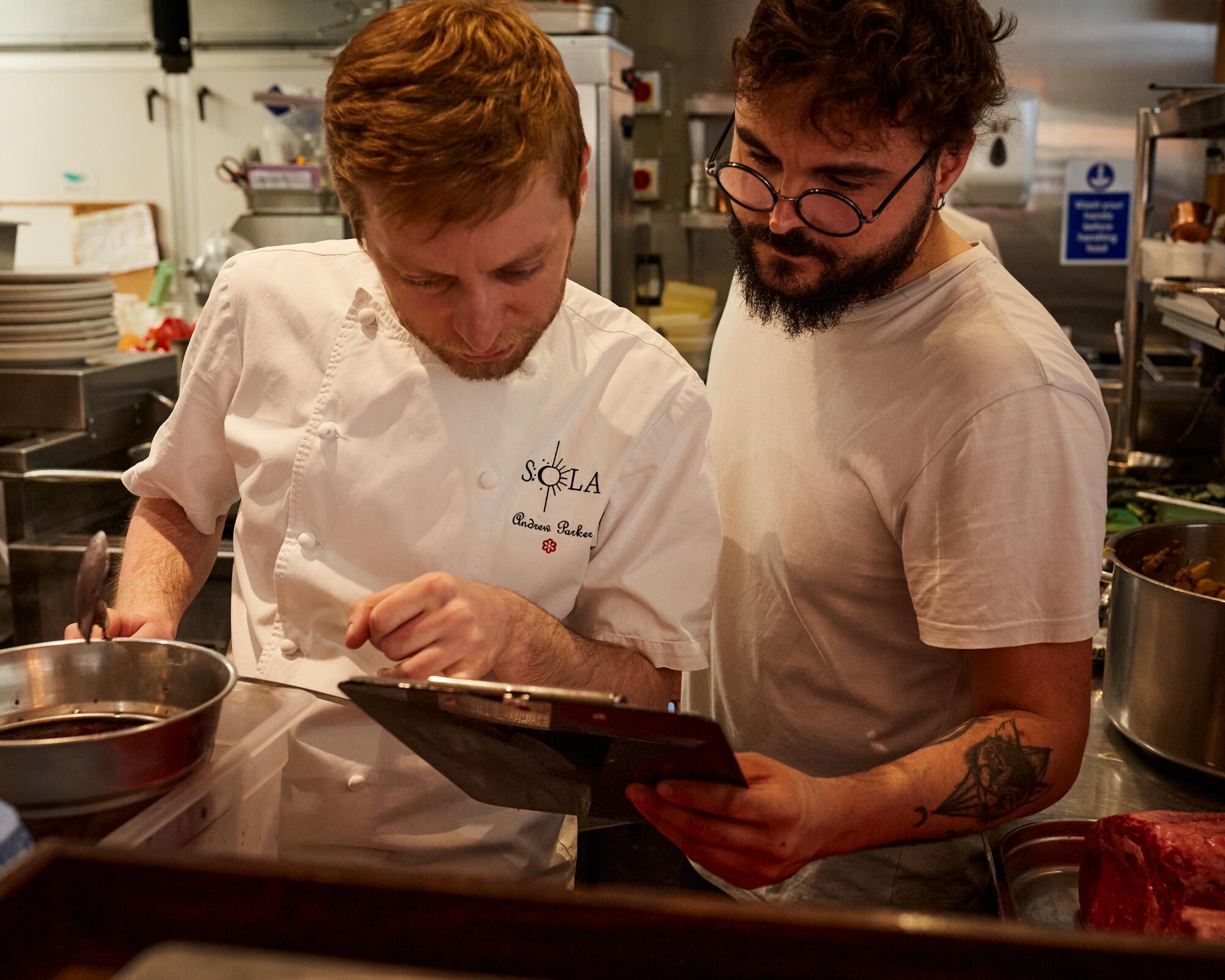
“Some people like to use local and minimize their carbon footprint. We do too, but we are in the market of delivering the absolute best we can do.… It just so happens for us that the best pistachios [are] from California,” says Garvey, who grew up in Barcelona to a French-Spanish-Moroccan mother and an American father and got his start as a teen taking out trash and washing dishes at an Italian restaurant on Las Ramblas. “The olive oil that we get from California is for a specific vinaigrette and a specific style. It’s quite peppery.”
Few European wines make the list. Those from California — Los Olivos, Santa Ynez and Santa Cruz County — dominate along with a sprinkling of bottles from New York’s Finger Lakes region. They’re chosen by a Connecticut-born sommelier who previously purchased wine for Whole Foods.
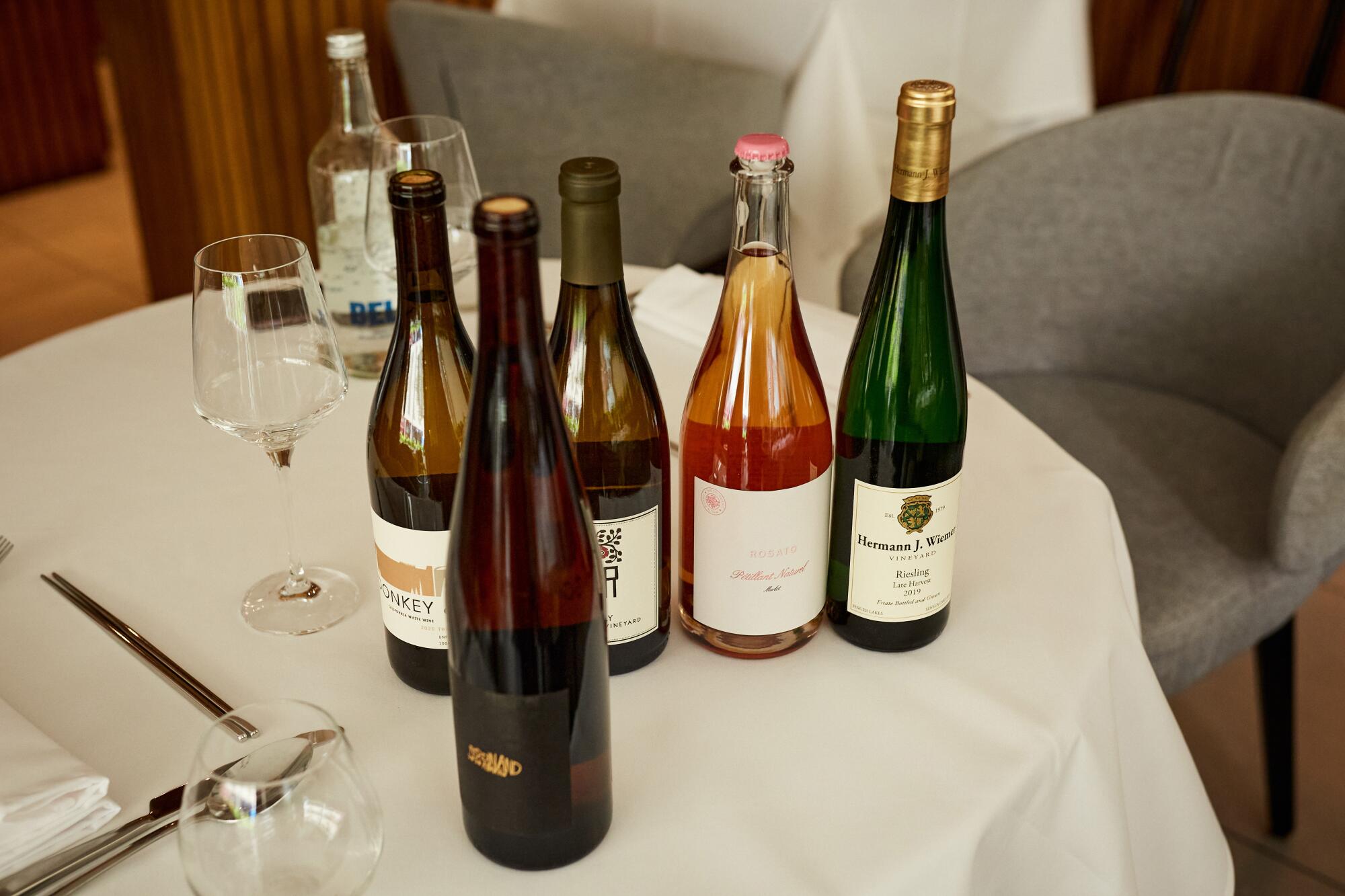
Trained at some of the world’s most acclaimed restaurants — the late El Bulli in Spain’s Catalonia region, Noma in Copenhagen and RyuGin in Tokyo — as well as Picasso at the Bellagio in Las Vegas and the former Joe’s Restaurant in Venice (Los Angeles), Garvey launched SOLA in 2019 after several years running a more casual tapas restaurant in the same nearly 1,300-square-foot space. His mother passed away years ago. His father, a former NBC executive, calls Toluca Lake home, though Garvey hasn’t been to Southern California in 13 years.
To him — and many in this part of the world — California cooking doesn’t require a particular ingredient or dish. It doesn’t even necessitate Latin flavors, a bold statement for a restaurant inspired by a part of the U.S. where taco trucks and street sellers hawking mangoes covered in chili are ubiquitous.
It also doesn’t need for someone to have ever set foot in California. To Garvey and many others, California cuisine, instead, is a “philosophy.”
That may sound like the words of a detached guru or a stoned hippie, but he’s not entirely wrong.
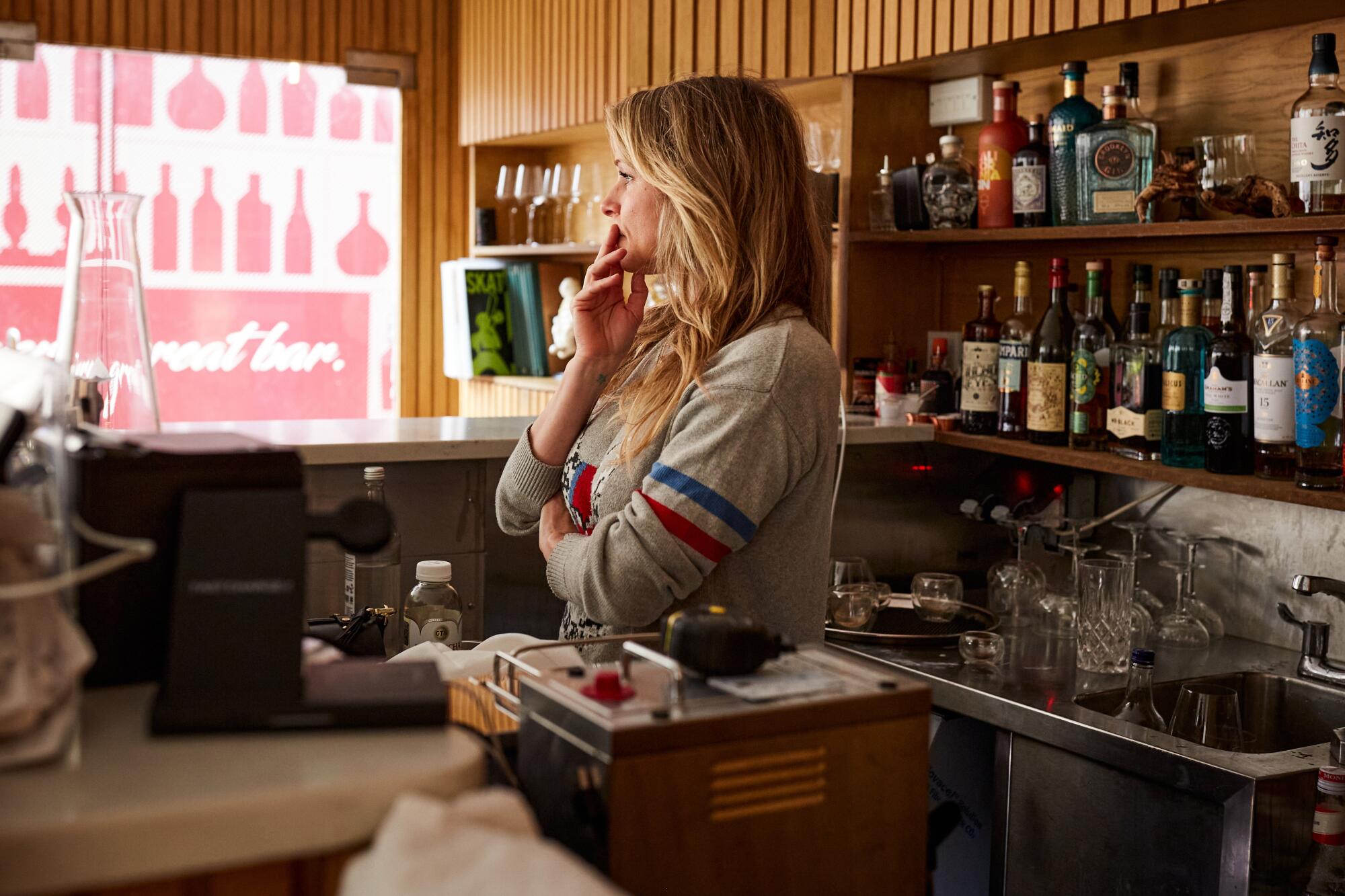
There was a time when classic French cuisine was regaled beyond any other. Chefs in the U.S. looked to Europe for culinary training and inspiration. Preset menus with heavy, creamy dishes were found in the best restaurants of Los Angeles, New York and San Francisco.
Something changed in the 1970s and 1980s, as California’s burgeoning counterculture and environmental movements meshed with the growing culinary and political influences of immigrant communities from Asia and Latin America. It all produced what’s now known as “California cuisine,” a vague catchall at best to those not steeped in its history. A similar desire for fresh, unprocessed dishes spawned the Slow Food Movement in Italy, a country that, like California, allows the elements and the land to conspire.
Born in South Korea, Christian Morales was raised by a Mexican abuela in East L.A. At his Mexican restaurant in Seoul, he’s re-creating the flavors of the home he can’t return to since being deported 17 years ago.
“It was this idea that, at the time, seemed revolutionary — talking directly with local farmers, even listing them on your menu, changing your menu because of what was in season,” says Joyce Goldstein, 86, who worked in the early days at Chez Panisse, the pioneering Berkeley restaurant that launched in 1971, and later ran Square One in San Francisco.
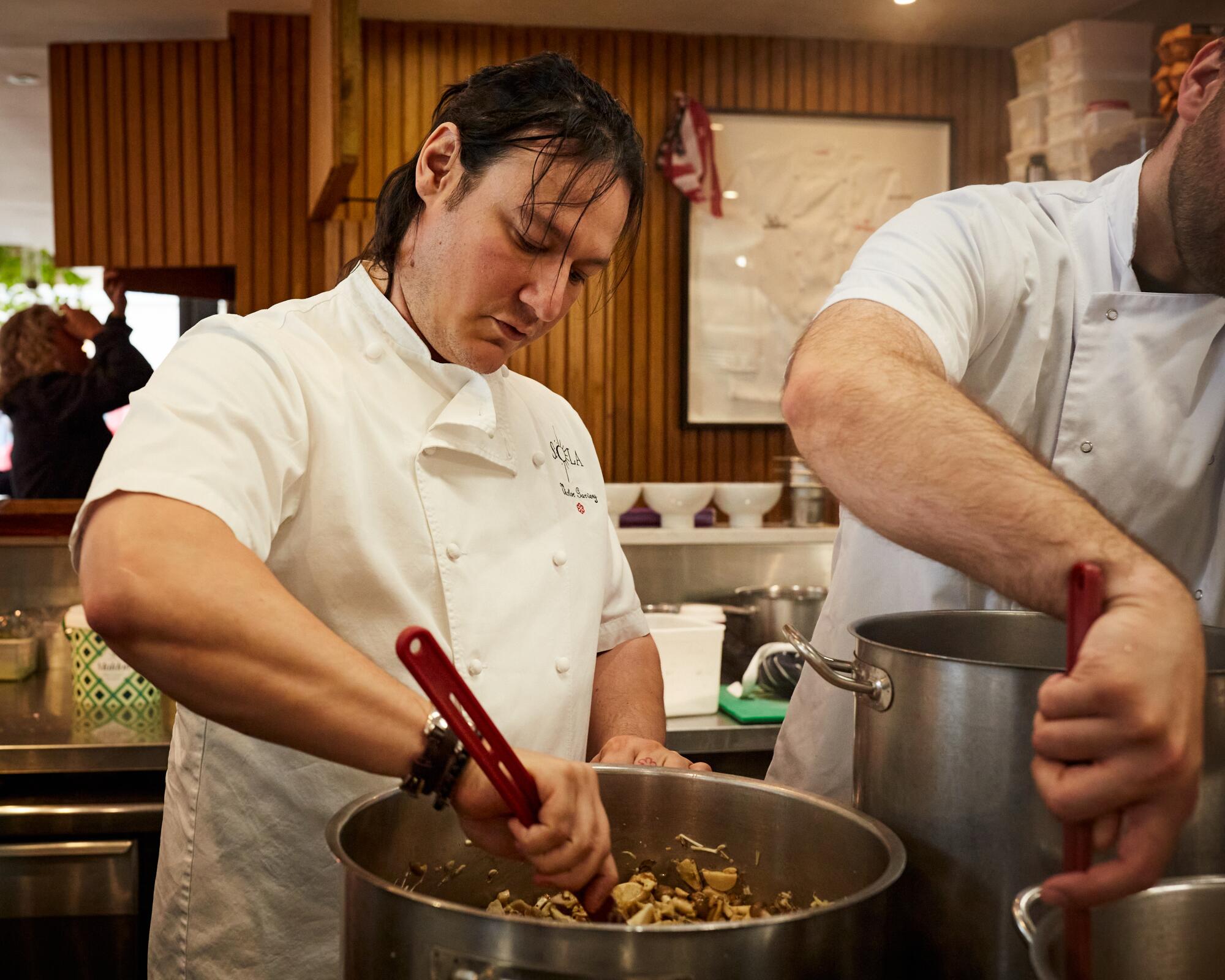
“These things seem so common now. They weren’t always,” says Goldstein, who wrote “Inside the California Food Revolution: Thirty Years That Changed Our Culinary Consciousness.”
Restaurants in the Bay Area and Los Angeles — Spago (today in Beverly Hills, originally on the Sunset Strip in West Hollywood) and Michael’s in Santa Monica among them — were pivotal, says Silverton, who worked at both and now owns a variety of restaurants, including Pizzeria Mozza in London and Osteria Mozza in Singapore.
Silverton described California cuisine as such: “Fresh, local and seasonal ingredients fairly simply prepared to promote those ingredients — not to mask.”
Today, the phrase “farm-to-table” — a throwback to earlier days when the wholesale, mass-scale food industry didn’t exist — has taken hold across the world, especially in Europe. Much of it is attributed to California, but is the state, which today has the fifth-largest economy in the world, alone to thank?
“I think the food scene even started earlier in London,” says Jonathan Woolway, chef director at St. John, a Michelin-starred restaurant that since its launch in 1994 has become known for its modern take on traditional British dishes (grilled ox heart and deep fried tripe grace the menu). St. John had announced a new location in Culver City before the pandemic changed plans.
“The influence between here and California might be a two-way thing,” Woolway said. “Good food, good produce by chefs is not something that originates anywhere. It belongs everywhere to everybody. You can find that cuisine wherever you go.”
Some American chefs have also taken a swipe at the idea of California cuisine, describing it as akin to a lack of creativity. “They don’t manipulate food, they just put figs on a plate,” David Chang, founder of New York’s Momofuku and chef of Majordomo in Los Angeles, famously said of San Francisco chefs as he spoke at an event alongside Anthony Bourdain more than a decade ago.
Still, the longing for California — where ocean, desert, verdant hills and snow-capped mountains are all tucked into a few-hours’ drive — beckons Europeans the same way the old-world charm of cobblestone streets and medieval castles draws Americans.
Portugal, with its warm climate, plentiful sun and cheap cost of living, has become a destination for Californians.
“The U.S. and U.K., we have this innate love for one another and obsession for one another,” says Jesse Burgess, a food video blogger who has amassed millions of viewers on YouTube as he’s traveled Europe and the U.S. with his business partner, Will Warr. “It’s a feeling too that seems to extend to Europe, especially [when] it comes to food. Everyone wants a good American burger.”
(A few years ago, when In-N-Out staged a one-day pop-up in northwest London and flew in patties and potatoes from the U.S., hundreds of Britons waited five hours before the chain ran out. Petitions regularly circulate for it to return.)
Guillaume Guedj, a Parisian who this spring relocated to Los Angeles to launch his second location of Mr. T, a buzzy Le Marais bistro, put it another way.
“I know this is a thing people always say, but Los Angeles is really diverse, especially in ways that we in Europe are not,” Guedj says. “There are so many different cultures in L.A. Korean, Thai, Japanese, Mexican and more.”
For many Europeans, it’s simply avocado toast that is their California. Its modern origins are debated, with Sydney at times winning out, though few argue against the fact that the Golden State perfected the dish. (And perhaps is sick of it, though global trends — like prophets — fade much slower than in the places where they begin.)
“In Italy, we have amazing food. We are very attached to our tradition but especially in some big cities, people are becoming very curious regarding new tastes, ‘fast good food,’” says Federica Sala, who co-founded Milan’s Fancytoast after sampling the dish during her travels in Los Angeles. (It bills itself as offering “epic toast from the West Coast.”)
This story is part of our Global California project
Our correspondents are traveling the globe, sharing stories that examine the complex relationship between the West Coast and the rest of the world.
Like the cuisine elsewhere on the California menus of Europe, the foods don’t always mesh strictly with the concept (there is little Californian about toast with pulled pork and potato, one of the dishes at Fancytoast).
But as Garvey, the chef and owner at SOLA, views it, authenticity is only part of the equation. It’s also, he says, what draws you in.
“Food is about taste,” he says. “It’s about experience. It’s about what you enjoy. It’s culture, chemistry and identity all in one.”
For Garvey, it was training in Japanese and Californian kitchens, and his heritage on his father’s side, that brought him to make his own version of Los Angeles in a city that is easily its opposite.
He also admits that, with the blowtorches, dry ice and more contraptions that grace the kitchen and table-side service at SOLA, some of the simplicity of California cuisine is lost.
“Authenticity is a stifling concept in the culinary world because you are restricting yourself. Why on earth would you? If your grandmother had access to wonderful ingredients of the world, do you think she would grow up cooking the way she did?” Garvey says. “I draw my influence from an era of fine California dining, Thomas Keller and David Kinch,” he says, naming the chefs of the French Laundry in Yountville and Manresa in Los Gatos.
Ask a Reporter is the live meetup series where Los Angeles Times journalists discuss the news and answer questions about the stories we cover.
On a recent evening, customers trickled into the dining room, where they were offered a canapé — a small, savory pastry — baked with aged parmesan to whet their appetites. Afterward, wild Pacific salmon — prepared three ways — arrived at tables, as a sommelier suggested pairing it with an Albariño made in Lodi, Calif.
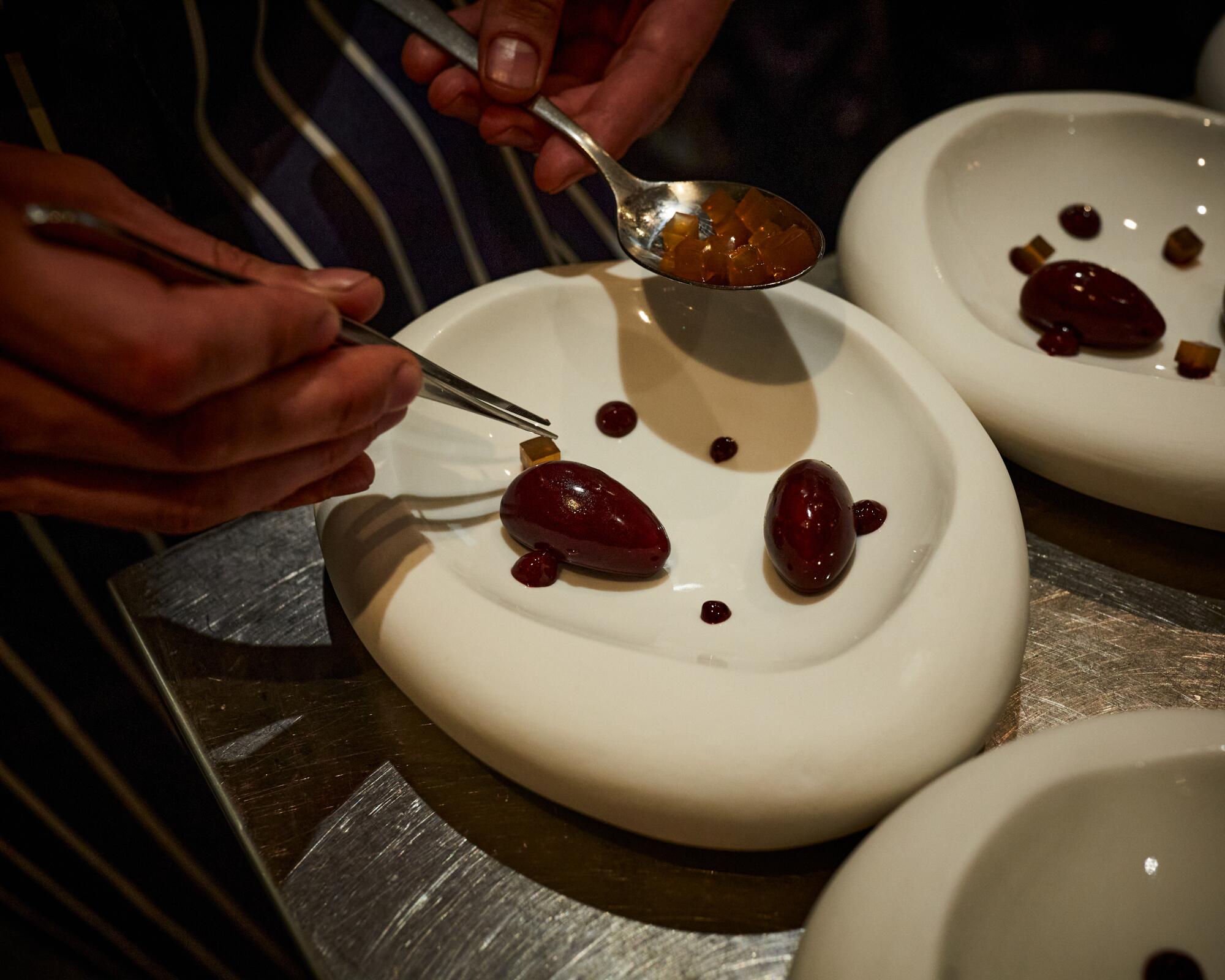
As he dressed carefully shaped pearls of foie gras by the small kitchen counter, Garvey looked through the street windows. Passersby paused at the storefront, glancing at the menu posted outside with its illustration of sun rays on the “o” in SOLA and a wine list that advertised an “emphasis on the West Coast.”
It was an unusual sight in this neighborhood of Vietnamese and Italian bistros, seafood restaurants and gay bars. But Garvey was glad for the attention.
He rubbed the silver rings on his left hand. One formed an “S” for his favorite hero, Superman. Another said “L.A.” for the Dodgers, though he’s not much of a fan. Between them was a tattoo of the red Michelin star. Together, it spelled “SOLA.” He smiled.
Times staff writer Rachel Schnalzer contributed to this report.
More to Read
Global California Alert
Receive an alert every time there's a new story in The Times' Global California project, showcasing the connections between California and the world.
You may occasionally receive promotional content from the Los Angeles Times.


